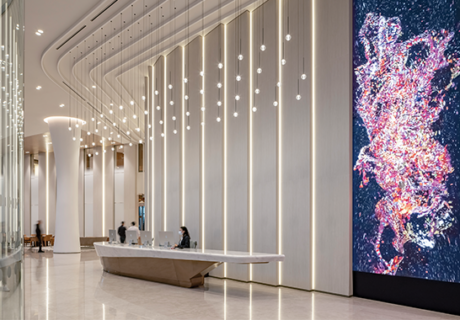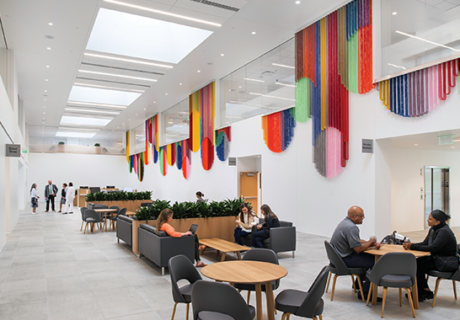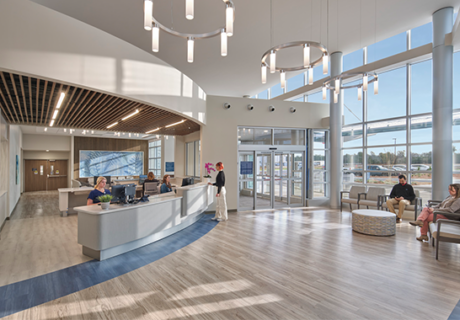2021 Showcase Award Of Merit: Pieces Of The Whole
The Warren Clinic is a modular clinic prototype developed for Saint Francis Health System to use across different sites in the Tulsa, Okla., area. The solution can be adapted in various configurations based on the specific needs of a location, leveraging an onstage/offstage organization and generous daylighting and views. Further, the design maximizes the existing pink brand color of the health system to create a branded glass wall on the building exterior to establish an iconic architectural element. The Award-of-Merit-winning project was submitted to the Design Showcase by CallisonRTKL. Here, project leads Eurico Francisco, principal, and Dana Brandle, associate principal, both of CallisonRTKL (Dallas), share some insight on some of the design solutions most celebrated by the jury.
Healthcare Design: You were tasked by the client to establish a clinical model that would be adaptable to various sites. How did you identify this specific approach as the solution?
Eurico Francisco: We tested and developed a modular approach that could compress, expand, and morph according to each location and demand, while always maintaining critical common elements such as workflow, protocols, access to views and daylight, and branding, among others. Our interdisciplinary, in-house team included architects, interior designers, and brand specialists, and working toward common goals proved to be key in achieving the project objectives. Key stakeholders, inclusive of administrators, department managers, and providers/ clinicians, were also engaged before and during design. By combining a compact and flexible footprint with boundless views to the exterior, the module is about merging efficiency and delight, which isn’t always the case in similar buildings. Caregiver and patient needs have been addressed with no compromises to performance or environmental quality.
Tell us about the ways your team had to anticipate various applications of the module and how it’s designed to flex.
Francisco: During the programming phase, we analyzed exam room-to-physician ratios to determine the ideal future state. “Day in the life” exercises were used to model typical physician flows and how support and other staff impact the overall experience. Coupled with the patient journey, a model was developed to replicate ideal clinical scenarios and determine the number of exams rooms needed and location of critical support areas.
Through our extensive research, our team determined that a modular pod concept around four physicians and 12 exam rooms worked best operationally. When multiple pods are linked together, certain secondary support spaces, such as supply storage and staff lounges, can be shared. The linking of the modular pods is what allows each given clinic site to flex programmatically to fit the needs of each community it serves.
Our jurors applauded the generous access to daylight that’s delivered. How did the design process help you achieve this?
Francisco: During a rigorous visioning session involving leadership and end users, such as administrators, department managers, physicians, and clinicians, our team applied our understanding of the positive results of integrating natural light into healthcare spaces and leveraged the benefits of our unique modular design approach to land on the design theme of “Light from Above.” This design approach combined the evidence-based benefits of daylight with the spiritual context that Saint Francis Health System and Warren Clinic strive to emulate in all their facilities. Our primary design goal for the project was always to create an exceptional experience for the patients, families, and staff. We truly feel that infusing natural light throughout the space was key in enhancing well-being for all visitors and crafting a positive experience.
Operationally, the modules are quite efficient. How did you approach the flow of both the patient journey and clinical functions?
Dana Brandle: [The client] wanted a new clinical model that improved patient outcomes and enhanced staff performance. To accomplish this, our team approached the patient experience by integrating the following key tenets:
• Separate flows for staff and visitors—The separation of the two flows is the nucleus of the clinic model. The Warren Clinics turn the traditional clinic inside-out, creating an onstage/offstage approach. With this, patients access exam rooms through circulation that is separate from staff, providing patients with a quieter, more private experience.
• Minimal/dispersed waiting areas—Upon entry, visitors are escorted or directed to dedicated, decentralized waiting areas. These waiting zones are located outside each exam room, giving patients direct access to the exam room. Patient flow is greatly improved through this approach, along with the elimination of unnecessary interaction between patients.
• Discrete staff work area—Staff work areas and circulation are separate from patient and visitor circulation throughout the clinic setting. This maximizes privacy/confidentiality and minimizes distractions, allowing for each provider’s time in the exam room to be maximized and focused on patient care.
The results of these key operational elements are improved staff efficiency, allowing more patients to be seen in a given day, and a collaborative staff environment that optimizes patient care. From the patients’ perspective, they enter a setting with minimal wait times. If they do happen to wait, it’s in a designated area, adjacent to their exam room, with a view to the exterior.
Branding plays a starring role on this project, particularly the pink feature wall on the exterior. How did you land on that bold choice?
Brandle: The legacy of Saint Francis Health System is embodied in its main Yale Avenue campus, which is often called “the pink hospital on the hill” by Tulsa locals. That iconic Saint Francis pink inspired us to develop the concept of a branded glass wall infused with varying pink tones as a front-facing element of the prototype design. Bold, bright, and uniquely “Saint Francis,” our proposed design would act as a visual brand icon and an element people could identify and engage with as they approach the site. As a glowing beacon at night, the wall would also reinforce the clinic’s connection to the community it serves.
The prototype has been delivered multiple times around Tulsa. How has it evolved with continued iterations?
Brandle: Our team understood that each new site would be unique and would necessitate a customized solution while still adhering to the prototype design and standards. We recognize that no design is a “one size fits all” solution. As we continue to implement the modular prototype design in new locations, we are continually evolving and altering certain aspects to meet not only the parameters of each site but the needs of each specific community.
After living in the first-generation clinics for about a year, the owner invited our team to conduct a post-occupancy evaluation to identify any lessons learned that could be incorporated into future sites. We developed a list of mostly small design modifications, but perhaps the most significant changes were related to patient intake. The first-generation clinics included a reception/greeter desk, but volunteers were not always available to staff that station. A vacant desk and frosted glass between the reception desk and the adjacent registration booths made it difficult for patient service representatives to greet arriving patients. At subsequent clinics, the reception desk was eliminated along with the frosting on the glass to allow the patient service rep to make eye contact with and greet arriving patients. Also, after the first-generation clinics were operationalized, and it became apparent that the throughput of exam rooms was working as planned, we eliminated the overflow waiting area from the prototype.
Jennifer Kovacs Silvis is editor-in-chief of Healthcare Design. She can be reached at jennifer.silvis@emeraldx.com.







